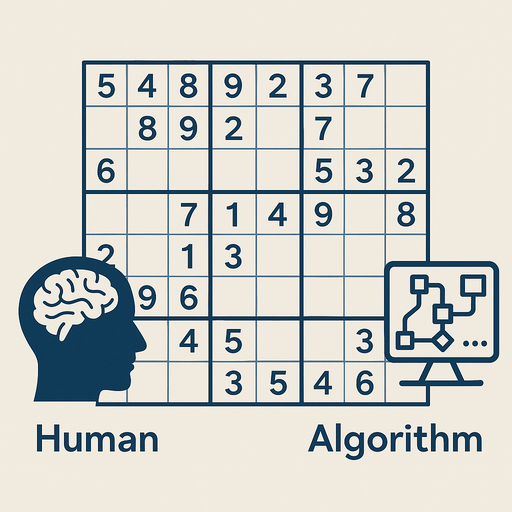
Can an Algorithm Think Like a Human Solver?
Every Sudoku expert knows that feeling — staring at a nearly complete grid, stuck between two possibilities, and suddenly seeing the answer. It’s not logic in the strict sense. It’s intuition — a quiet spark that whispers, “It must be here.”
But here’s the fascinating question: could a machine ever have that same spark? Could an algorithm “think” like a human solver, with creativity, patience, and the occasional wild hunch?
Welcome to the quiet duel between man and machine — where logic meets learning, and every empty square becomes a test of what it means to truly understand.
The Rise of the Algorithmic Solver
Sudoku and computers have always been natural companions. After all, the puzzle’s rules are simple, finite, and perfectly logical — ideal territory for algorithms. Early computer solvers used brute force: they’d simply test every possibility until something fit. It worked… but it wasn’t elegant.
Over time, more sophisticated programs emerged, using constraint propagation and backtracking — two techniques eerily similar to how experienced players think. The computer identifies cells that have limited possibilities, fills them in, then works through chains of cause and effect. When stuck, it rewinds — just like a human might erase a few digits and rethink the logic.
Modern AI-based solvers go even further. Instead of relying solely on code-defined rules, they can learn patterns from millions of existing puzzles. Neural networks trained on Sudoku datasets now solve even the hardest grids in milliseconds — often faster than humans can blink.
But are they really “solving”… or just calculating?
What Makes Human Solving So Unique
Humans don’t solve Sudoku by crunching probabilities. They blend logic, intuition, and emotion in ways algorithms can’t quite replicate.
When you or I approach a grid, we:
Spot visual symmetries and patterns.
Feel drawn to certain areas without consciously knowing why.
Use memory — “I’ve seen this kind of setup before.”
Experience frustration, curiosity, and the small thrill of progress.
In other words, our thinking isn’t linear. It’s full of leaps, shortcuts, and gut instincts. Psychologists call this heuristic reasoning — a mix of logic and intuition that helps us make fast, flexible decisions.
A machine, meanwhile, has no hunches or emotions. It doesn’t feel the tension of uncertainty or the joy of a breakthrough. It just follows rules — flawlessly, but soullessly.
That’s why even the fastest solvers can’t make us feel what human solving does. For us, Sudoku isn’t just a test of logic — it’s a journey of focus and flow.
Intuition vs. Calculation
The biggest gap between algorithms and people lies in how we handle ambiguity.
Algorithms eliminate uncertainty through computation — they explore every path until only one remains.
Humans live comfortably with uncertainty. We explore selectively, take risks, and backtrack emotionally, not mechanically.
Interestingly, this makes human solvers more efficient on certain types of puzzles. While an algorithm might check thousands of permutations, an experienced player can jump directly to a key deduction with a flash of insight.
It’s the same reason we love solving: Sudoku trains the brain’s ability to see connections before they’re fully logical. It’s creativity in the service of clarity.
When Machines Surprise Us
And yet, there are moments when algorithms start behaving eerily human. Some advanced AI Sudoku solvers, when visualized, appear to “focus” on specific regions of the grid — much like a person’s gaze pattern. Their neural networks learn which cells are most “informative” to examine next.
This isn’t true awareness, of course, but it’s an impressive imitation. AI doesn’t know why it’s looking there — it just recognizes, through probability, that certain configurations lead to faster solutions.
That’s where the line blurs. The more AI models learn from human strategies, the closer they come to replicating the rhythm of our logic — not through consciousness, but through statistical mimicry.
Why Humans Still Have the Edge
Despite AI’s speed, there’s one arena machines can’t touch: the experience of solving.
Humans find meaning in the process itself — the tension, the pattern recognition, the calm satisfaction of order restored. We take breaks, sip coffee, and come back with fresh eyes. We learn about our own patience, focus, and thought patterns in the process.
For an algorithm, Sudoku is over the moment it’s solved. For a human, Sudoku is alive while we’re solving it. That difference — the journey — is where the beauty lies.
The Perfect Partnership
Rather than rivals, maybe humans and algorithms make the perfect Sudoku teammates.
Computers can handle massive data, generate puzzles, and test difficulty levels with precision. Humans, on the other hand, bring the creativity to design interesting, elegant challenges — the ones that feel good to solve.
That’s exactly why puzzle creators now use both: algorithmic generators to produce balanced grids, and human editors to ensure the puzzles are intuitive and satisfying. The best of both worlds — precision and soul, logic and artistry.
The Future of Solving
As AI keeps evolving, it may eventually learn to imitate human intuition so well that the difference becomes invisible. But will it ever understand Sudoku — the quiet thrill of filling that last square, the meditative rhythm of numbers falling into place? Probably not.
Because understanding isn’t just about solving — it’s about feeling the puzzle as it unfolds.
So while algorithms might rule the leaderboards, the true masters of Sudoku remain the humans who still pause, breathe, and smile at the grid before the first move.
And if you want to see where logic meets instinct, solve a few puzzles, and decide for yourself: when you play, are you more like the algorithm… or the artist?

 German
German
 Japanese
Japanese
 Arabic
Arabic
 Spanish
Spanish
 French
French
 Russian
Russian
